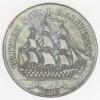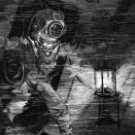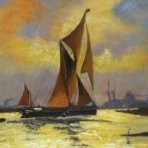MORE HANDBOOKS ARE ON THEIR WAY! We will let you know when they get here.
×
-
Posts
2,286 -
Joined
-
Last visited
Reputation Activity
-
 chris watton got a reaction from Thukydides in HMS Surprise 1796 (prototype) by James H - Vanguard Models - 1:64
chris watton got a reaction from Thukydides in HMS Surprise 1796 (prototype) by James H - Vanguard Models - 1:64
My usual rule of thumb is this – Any warship pre 1800, I will always insist of red inner bulwarks and carriages unless I have strong evidence to the contrary. After this date, I feel I can be a little ‘looser’ with the options, using off-white, ochre or green, depending on date and type of vessel. As you mention, Surprise is being depicted (for the prototype at least) to those later dates, so colour scheme is a little more flexible.
But again, it will always be up to the modeller what they want to do – they are furnished with options.
Oh, meant to ask - what colours were the cutters, was it a red one and green one, or red and blue, I cannot remember!
-
 chris watton got a reaction from Oboship in HMS Surprise 1796 (prototype) by James H - Vanguard Models - 1:64
chris watton got a reaction from Oboship in HMS Surprise 1796 (prototype) by James H - Vanguard Models - 1:64
There is quite a lot of Information out there that suggests ochre for inner bulwarks and carriages for the early 1800's. My main source for this particular kit is the book The Frigate Surprise, by Brian Lavery and Geoff Hunt. Victory inner bulwarks and carriages are also yellow ochre, and she is depicted as per the exact same time frame as Surprise.
But, as always, the colour scheme is never gospel, no one will insist the modeller uses the colours we suggest you can paint them red, yellow, even green or pink if you wish!
Conversely, how do we know definitely they were painted red, or at all?
ETA - The reason I did the carriage names in both white and black is to give the modeller the choice of how they wish to paint them, red for the white decals, lighter colours like ochre use the black.
-
 chris watton got a reaction from Thukydides in HMS Surprise 1796 (prototype) by James H - Vanguard Models - 1:64
chris watton got a reaction from Thukydides in HMS Surprise 1796 (prototype) by James H - Vanguard Models - 1:64
There is quite a lot of Information out there that suggests ochre for inner bulwarks and carriages for the early 1800's. My main source for this particular kit is the book The Frigate Surprise, by Brian Lavery and Geoff Hunt. Victory inner bulwarks and carriages are also yellow ochre, and she is depicted as per the exact same time frame as Surprise.
But, as always, the colour scheme is never gospel, no one will insist the modeller uses the colours we suggest you can paint them red, yellow, even green or pink if you wish!
Conversely, how do we know definitely they were painted red, or at all?
ETA - The reason I did the carriage names in both white and black is to give the modeller the choice of how they wish to paint them, red for the white decals, lighter colours like ochre use the black.
-
 chris watton reacted to Kevin in Bounty by Kevin - Artesania Latina - 1:48 - started August 2025
chris watton reacted to Kevin in Bounty by Kevin - Artesania Latina - 1:48 - started August 2025
first build post day 3
day 1
clear room, only long enough to get a good clean done, and did the kit review photos
After marking identification numbers on all the parts All the plywood bits removed . shame they dont do this at the stage they are made, after test fitting
day 2
i painted them in Oak, using the OcCre dye, then made the hull up using titebond original
too yellow
day 3
what about walnut?
im happier with that, becomes a nice shade on top of the oak
lower hold forward half deck
on one side of each plank i marked with a permanent marker - in black
painted the deck black, laid planks in a 3 shift butt system
drilled holes to represent nails
stained in oak
this is how she stands tonight
-
 chris watton reacted to AJohnson in HMS Surprise 1796 (prototype) by James H - Vanguard Models - 1:64
chris watton reacted to AJohnson in HMS Surprise 1796 (prototype) by James H - Vanguard Models - 1:64
There are also very good articles on the topic in the Mariners Mirror. I forget the sources, but Red Ochre was removed from the approved Admiralty list of paint pigments in 1807.
So for the “real” Surprise red would be fine if you chose to model that. But for the “fictional” Surprise many of the stories are based around historical event in the 1808 - 1817 time frame. So like Chris I will be following the Lavery/Hunt book as my reference. Will be nice to see something different to red ochre! 😁
-
 chris watton got a reaction from Ishmael in HMS Surprise 1796 (prototype) by James H - Vanguard Models - 1:64
chris watton got a reaction from Ishmael in HMS Surprise 1796 (prototype) by James H - Vanguard Models - 1:64
There is quite a lot of Information out there that suggests ochre for inner bulwarks and carriages for the early 1800's. My main source for this particular kit is the book The Frigate Surprise, by Brian Lavery and Geoff Hunt. Victory inner bulwarks and carriages are also yellow ochre, and she is depicted as per the exact same time frame as Surprise.
But, as always, the colour scheme is never gospel, no one will insist the modeller uses the colours we suggest you can paint them red, yellow, even green or pink if you wish!
Conversely, how do we know definitely they were painted red, or at all?
ETA - The reason I did the carriage names in both white and black is to give the modeller the choice of how they wish to paint them, red for the white decals, lighter colours like ochre use the black.
-
 chris watton got a reaction from Mr Whippy in HMS Surprise 1796 (prototype) by James H - Vanguard Models - 1:64
chris watton got a reaction from Mr Whippy in HMS Surprise 1796 (prototype) by James H - Vanguard Models - 1:64
There is quite a lot of Information out there that suggests ochre for inner bulwarks and carriages for the early 1800's. My main source for this particular kit is the book The Frigate Surprise, by Brian Lavery and Geoff Hunt. Victory inner bulwarks and carriages are also yellow ochre, and she is depicted as per the exact same time frame as Surprise.
But, as always, the colour scheme is never gospel, no one will insist the modeller uses the colours we suggest you can paint them red, yellow, even green or pink if you wish!
Conversely, how do we know definitely they were painted red, or at all?
ETA - The reason I did the carriage names in both white and black is to give the modeller the choice of how they wish to paint them, red for the white decals, lighter colours like ochre use the black.
-
 chris watton got a reaction from alde in HMS Surprise 1796 (prototype) by James H - Vanguard Models - 1:64
chris watton got a reaction from alde in HMS Surprise 1796 (prototype) by James H - Vanguard Models - 1:64
There is quite a lot of Information out there that suggests ochre for inner bulwarks and carriages for the early 1800's. My main source for this particular kit is the book The Frigate Surprise, by Brian Lavery and Geoff Hunt. Victory inner bulwarks and carriages are also yellow ochre, and she is depicted as per the exact same time frame as Surprise.
But, as always, the colour scheme is never gospel, no one will insist the modeller uses the colours we suggest you can paint them red, yellow, even green or pink if you wish!
Conversely, how do we know definitely they were painted red, or at all?
ETA - The reason I did the carriage names in both white and black is to give the modeller the choice of how they wish to paint them, red for the white decals, lighter colours like ochre use the black.
-
 chris watton got a reaction from Mr Whippy in Duchess of Kingston by DB789 - FINISHED - Vanguard Models - 1:64
chris watton got a reaction from Mr Whippy in Duchess of Kingston by DB789 - FINISHED - Vanguard Models - 1:64
Very nice indeed, very well done!
-
 chris watton reacted to James H in HMS Surprise 1796 (prototype) by James H - Vanguard Models - 1:64
chris watton reacted to James H in HMS Surprise 1796 (prototype) by James H - Vanguard Models - 1:64
For the last day or two, I've been concentrating on some of the smaller stuff, as I usually do at this stage in a VM build. I like to get some stuff out of the way early, such as guns, grates, etc. This update will look at the main guns and the stern chasers. The main guns are constructed like Indy, meaning the barrels aren't actually fitted until the model is almost complete. This means the capsquares in the carriage sides, are open at the front, allowing the builder to slip the barrel through the port and glue the part in place. The stern chasers are more traditional. Here, the barrels are fitted through whole capsquares during assembly.
Fourteen on the main guns come complete with name decals. When the cart is painted, some gloss varnish is applied and when set, the decals are added to the carts before being sealed and matt varnish applied. Here you can see the names.
PE is used for eyelets and the small stop bar which sits between the sides. The latter is painted ochre to match the cart.
Wheels are now added....remember, large ones at the front, so as to deal with deck camber.
The barrels are NOT glued at this stage. The carts will plug into slots in the deck, and the barrels will be one of the very last things you fit as you build Surprise.
Chasers: Almost identical in formula to the main guns, except the barrel is fitted as you close the carriage sides.
I'm currently working on carronades. I might be able to update today, but maybe not. I have a visitor later who operates the Modelkits Stuff YouTube channel, and he's coming for a preview of the work and sheets of parts etc.
-
 chris watton got a reaction from mgatrost in HMS Surprise 1796 (prototype) by James H - Vanguard Models - 1:64
chris watton got a reaction from mgatrost in HMS Surprise 1796 (prototype) by James H - Vanguard Models - 1:64
Bow area is always an issue, more so with built up forecastle bulwarks. My mandate to myself with this was to try and make this area as strong as possible to help minimise possible distortion that often sets in with such curves around the bow, with some areas looking more angled than curved. But damn that area was a nightmare.... (As in trying to do this so that it is easy for the modeller to understand and build up).
I am so overdue designing a kit with a nice simple beakhead bulkhead!
-
 chris watton got a reaction from Ryland Craze in HMS Surprise 1796 (prototype) by James H - Vanguard Models - 1:64
chris watton got a reaction from Ryland Craze in HMS Surprise 1796 (prototype) by James H - Vanguard Models - 1:64
That's what my build is all about (It is, after all, still in the design and development stage)
-
 chris watton got a reaction from alde in HMS Surprise 1796 (prototype) by James H - Vanguard Models - 1:64
chris watton got a reaction from alde in HMS Surprise 1796 (prototype) by James H - Vanguard Models - 1:64
Just making sure all options for the final kit are fine
-
 chris watton got a reaction from Nightdive in HMS Surprise 1796 (prototype) by James H - Vanguard Models - 1:64
chris watton got a reaction from Nightdive in HMS Surprise 1796 (prototype) by James H - Vanguard Models - 1:64
Final pic of gun deck before upper deck is added to the old mule...
-
 chris watton got a reaction from Nightdive in HMS Surprise 1796 (prototype) by James H - Vanguard Models - 1:64
chris watton got a reaction from Nightdive in HMS Surprise 1796 (prototype) by James H - Vanguard Models - 1:64
Finalising the upper deck pattern now that bulkhead tabs have been removed, bowsprit fits like a glove..
-
 chris watton got a reaction from Ryland Craze in HMS Surprise 1796 (prototype) by James H - Vanguard Models - 1:64
chris watton got a reaction from Ryland Craze in HMS Surprise 1796 (prototype) by James H - Vanguard Models - 1:64
Yes, Tanganyika, I use this because it is much cheaper than pear (as my model will be thrown away), and it is easier to plank with, being much softer. This means I could plank the whole lower hull in one session. Only have it in 1x4mm though, and the kit second planking is 1x5 pear, so I had to use more planks....
You can see the upper deck beams below the jigs, not sure why you would think those jigs would be beams!
-
 chris watton reacted to Kevin in Bounty by Kevin - Artesania Latina - 1:48 - started August 2025
chris watton reacted to Kevin in Bounty by Kevin - Artesania Latina - 1:48 - started August 2025
kit contents
-
 chris watton got a reaction from RVB in Oseberg Viking Ship (v3) by Kevin - FINISHED - Pavel Nikitin - 1/25 - Started June 25 to August 25
chris watton got a reaction from RVB in Oseberg Viking Ship (v3) by Kevin - FINISHED - Pavel Nikitin - 1/25 - Started June 25 to August 25
Well done, Kevin, she looks superb!
-
 chris watton reacted to _SalD_ in NORDKAP 476 by _SalD_ - Billing Boats - 1:50 - RADIO
chris watton reacted to _SalD_ in NORDKAP 476 by _SalD_ - Billing Boats - 1:50 - RADIO
"Planking is complete; now I just need to fill the gaps and start sanding.
The stern still needs a bit of work."
-
 chris watton reacted to Beef Wellington in HMS Jason by Beef Wellington - Caldercraft - 1:64 - Artois-class frigate modified from HMS Diana 1794
chris watton reacted to Beef Wellington in HMS Jason by Beef Wellington - Caldercraft - 1:64 - Artois-class frigate modified from HMS Diana 1794
Its scary to note that my last update was 9 months ago, much has dragged me away from keeping current with other's builds on this wonderful site, and making progress myself. While not much, this brings me up to date.
Head Grating:
This caused much pondering! Like everything, this had to be scratch built. and wasn't quite sure whether I could pull of the gracefully curved gratings that grace many period models. In the end, this turned out to be a highly enjoyable little project. The main framing elements were built following the layout and dimensions of previously assembled components. The outside angled edge follows the curve of the main headrail, and the inside a foreshortened version. No real secret other than use of lots of templates and continual trial fitting. The larger framing elements were joined with a simple box joint for strength, the battens were individually shaped and glued end on. Once completed, the front of the seats of ease were attached to simplify final installation.
Catheads, fo'c'sl plansheer and breasthook:
With the gratings finalised, it was possible to install the catheads with some confidence. The breasthook was cut following dimension estimates from contemporary models (as much as possible) Prior to that however, the fo'c'sl plansheer was finalised, which required the underside where the catheads are located to be slightly angled to allow for the upward slope of the cathead given the overlap of the plansheer, and to ensure it sits flat.
Timberheads:
It was necessary t get my head around how I was going shape the timberheads, and figure out what was possible, so that I could both get some practice in shaping these and maximise the chance that these could be kept consistent and of an acceptable appearance. I did not want to have to redo the head rails as these had taken many hours to make. After some experimentation, the following approach seemed to provide the most consistent results for me. 2x5mm pear was used.
From left to right:
Preventer cuts were carefully made using a jig and #12 Exacto blade The edges were cut back gently to roughly preform the shape. I found the wood surface had a tendency to break off even with care so there were losses. Wipe on poly was applied at the cuts at this stage to both prove better visibility for further shaping, and also to harden the edges that had been formed The sloped faces were further refined, again carefully using a #12 Exacto blade, sanding sticks and microfiles. The top is deliberately made a little overlong as it makes shaping easier The top is reduced to final dimension... The overall height is reduced to final dimensions (in this case 10mm) Finalisation and installation of the main rail and grating:
The main rail could now be finally dimension and shaped. As identified in TFFM, it did prove necessary to shape for rear outside profile to ensure it fits nicely to the cathead. I couldn't find much in the way of detail here, but the AOTS Diana book shows a slight wedge of wood sitting between the hull and the head rail. I decided to add two small wedges to ensure the headrail is fully secured to the hull. The plansheer also had to be nicked to allow it to sit properly.
And with everything finally installed...I am greatly relieved and pleased with the way this has turned out as this proved to be a most challenging, but ultimately satisfying, adventure. The fore seats of ease have been made up and will ultimate slot into the grating, but these will not be installed until the placement of the boomkins is determined as everything is very tight in this small area.
-
 chris watton reacted to Beef Wellington in HMS Jason by Beef Wellington - Caldercraft - 1:64 - Artois-class frigate modified from HMS Diana 1794
chris watton reacted to Beef Wellington in HMS Jason by Beef Wellington - Caldercraft - 1:64 - Artois-class frigate modified from HMS Diana 1794
It has clearly been a very long time since last I was here and I hope that people remember me! Suffice to say it has been hard to make any progress beyond a snails pace. I last left off after focusing on the complex bow structures. To keep moving I needed to install the rough tree rail and the various supports as well as the Fretwork to the upper finishing. Dimensions were estimated from plans and contemporary model, and these all seem to vary to some degree.
I had held off making the fretworks as I wasn't sure of the approach, and I wanted to get a curved profile. In the end, shaped billets were made to size and shaped, thin 1mm square boxwood strip (which I had hand sanded down to ~0.5mm) was then glued to the upper and lower edges. Once dry, the back was cut away and finished by hand. This is where the piper must be paid for any prior size and alignment estimates- as things stood I'm estimating that this is maybe 1mm shorter than it should be per the various plans and diagrams (4mm vs 5mm), but this was necessary to sit appropriately.
Unfortunately, my progress was so slow making the rough tree rails that I neglected to take photos. These were cut from 2mm boxwood following the profile of the hull and were 3mm wide. The curved for'ad sections were made separately using a similar technique as taken for the decorative rails and then joining to the main rough tree rail. This follows the sheer of the deck, rather than the wale, so a template was made to ensure that these were positioned correctly. The timberheads were then added using 2x5mm pear strip., because these are continuations of the frames, they need to be perpendicular to the keel. There seems to be a huge amount of small variation on how these were constructed and captured on plans and models, and a variation even between the plans I have for HMS Jason showing these and the various Artois class models. The template was once again used to ensure the consistent height above the deck. Much of this process required fine adjustments using the Mk. 1 eyeball which seemed to take a considerable amount of time. In the end, I drew inspiration from model 1794-3 illustrated on page 19 of the AOTS Diana book. This has 2 curious semi-bulkheads installed in the timberheads, as well as being solidly built up at the stern. I have no idea what these are as I haven't seen them anywhere else. The mizen and main backstay stools have also been glued into position. Finishing up with some overall shots of where things stand (The quarter gallery lights are not attached, but were placed to get a sense for proportion when finalizing the fretwork)
-
 chris watton reacted to dafi in HMS Victory by dafi - Heller - PLASTIC - To Victory and beyond ...
chris watton reacted to dafi in HMS Victory by dafi - Heller - PLASTIC - To Victory and beyond ...
More on the casks soon :-)
In the meantime, a whole small flotilla has emerged from my 32-foot launch 🙂
The 7-oared pinnace is in a race with the fully loaded 14-oared launch, which has to pull the fully loaded launch with the water barrels. Next to it is another boat with fully stowed equipment and one where the launch is helping to weigh anchor. And of course a setting with set sails. Always the same hull, but with different contents and task each time. More on the individual deployment options soon. It remains exciting.
Here is the comparison one more time ...
... of the single-banked pinnace with the rowers always sitting on the opposite side ...
... and the double-banked 32-foot launch.
And another little tip on the technical side:
And I always propagate not to cold bend resin parts. After painting, the oars got quite a bend in the shaft. That's why I briefly dipped the parts in hot water.
You could really see how the parts straightened out in the water within 2-3 seconds by themselves. Like memory metals, really strong 🙂
The bent parts at the top and the hot-bathed and straightened parts at the bottom. The fact that the far left side still has a bend is not a mistake, but the curved rudder blades of the small and medium-sized boats.
XXXDAn
And I still have 2 boat shells.
... what do I do now, what do I do now ...
-
 chris watton reacted to dafi in HMS Victory by dafi - Heller - PLASTIC - To Victory and beyond ...
chris watton reacted to dafi in HMS Victory by dafi - Heller - PLASTIC - To Victory and beyond ...
And we continued with the lugger-rigged version of the large launch.
First came the masts. I took the measurements from W. E. May's summary, but they also correspond fairly closely to the French measurements. The strength of the lugger rig is its simplicity. Insert the pre-rigged mast, hook in the pairs of backstays on both sides with the standing end, hook the tackles in the middle, and belay the free end. The halyard of the sail is already sheared through in the masthead, so the sail is immediately hoisted, the tack, sheet and brail are secured, and off you go.
In my scrap box, I charmingly found a sample from my sandwich sail tests from 2017 – yes, I actually keep such things for that long – and the sizes I need fit quite well, even avoiding the messy areas. I developed the material back then to combine the advantages of fabric as an elastic material and paper for a more true-to-scale surface. Thin strips of restoration repair paper are ironed onto both sides of a layer of silk to create a sandwich that resembles closely the visual properties of the sails. It is also unbeatable for folding and stowing. However, at the time, I did not yet have a model that was ready for me to use it on ...
I took the angles from Steel's drawings, but I had to mark the radius at the bottom – one of the differences to French sails – with a pen and thread, as the radius is larger than my templates.
I shortened the furled sails by approx. 25%, i.e. below the lower reefing band, which I had also omitted for this purpose.
The surrounding leech was glued on and the eyes for the brails were added.
If necessary, I'll even clamp a sail in a vice 😉
And then it was time to fold and fiddle around.
And then it was adjusted to fit the storage space.
Together with the masts in place looks quite cheerful and full. Two barrels have also found their way there. Who can find them?
It's great to finally be able to use the sails developed eight years ago in a model myself. Some modeling friends have already impressively demonstrated their potential. Thank them for that.
And I'm already testing out the next crazy ideas for my boat collection...
XXXDAn
-
 chris watton got a reaction from AJohnson in Duchess of Kingston by DB789 - FINISHED - Vanguard Models - 1:64
chris watton got a reaction from AJohnson in Duchess of Kingston by DB789 - FINISHED - Vanguard Models - 1:64
Very nice indeed, very well done!
-
 chris watton got a reaction from Ryland Craze in HMS Surprise 1796 (prototype) by James H - Vanguard Models - 1:64
chris watton got a reaction from Ryland Craze in HMS Surprise 1796 (prototype) by James H - Vanguard Models - 1:64
Bow area is always an issue, more so with built up forecastle bulwarks. My mandate to myself with this was to try and make this area as strong as possible to help minimise possible distortion that often sets in with such curves around the bow, with some areas looking more angled than curved. But damn that area was a nightmare.... (As in trying to do this so that it is easy for the modeller to understand and build up).
I am so overdue designing a kit with a nice simple beakhead bulkhead!










